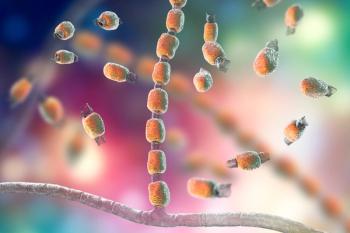
Just under the surface: Cytology of the skin (Proceedings)
Inflammatory lesions can occur due to infectious or non-infectious causes.
Inflammatory lesions can occur due to infectious or non-infectious causes. Compared to tissue cells, inflammatory cells are readily collected by aspirates and scrapings. Inflammation is characterized by the predominant cell type which helps to predict the underlying etiology.
Neutrophils indicate suppurative or purulent inflammation. Non-infectious causes include immune-mediated disorders, chemical irritation, neoplasia, and acute trauma. Infectious causes include most bacterial infections and some fungal organisms. Degenerative neutrophils (swollen, karyolitic nuclei) are commonly associated with the toxic environment induced by bacterial infections however degenerative changes also occur as cells become exposed on mucosal or external surfaces.
Macrophages may be seen in mixed, granulomatous, and pyogranulomatous inflammatory processes. Causes include yeast and fungal agents, foreign body reactions, certain bacteria (Mycobacteria spp.), hemorrhage, and chronic inflammatory conditions. Epithelioid macrophages have a wispy to epithelial appearance. These, and multinucleated cells, and are typical of granulomas making granulomatous inflammation difficult to distinguish from histiocytic neoplasia.
Lymphocytes and plasma cells are associated with allergic or immune reactions, some viral diseases, feline cholangitis, feline stomatitis and gingivitis, gastroenteritis, and vaccine reactions. Their presence can usually be differentiated from neoplasia by the heterogeneity of the lymphocyte population.
Eosinophils are associated with tissue parasites, neoplasia (lymphoma, mast cell tumor, melanoma, others), fungal organisms, protozoal organisms, eosinophilic granulomas, collagen necrosis, and hypereosinophilic syndrome.
Mast cells in low numbers are often seen in inflammatory lesions.
Infectious inflammatory conditions
Bacterial agents may be found in abscesses, contaminated surgical sites, and secondary to numerous underlying metabolic, allergic, and neoplastic disorders. Specific agents that may be recognized include Actinomyces/Nocardia (filamentous), Mycobacterium (negative staining), and Yersinia (bipolar 'safety pin'). Scrutiny of diplococci has increased recently, with additional concerns over MRSAs. Bacterial infection primarily induce a suppurative response, however the filamentous bacteria and Mycobacterium sp may induce a mixed to pyogranulomatous response.
Fungal diseases can be present as either cutaneous or subcutaneous lesions. The cutaneous diseases include those induced by dermatophytes (Microsporium, Tricophyton, or Epidermophyton), Candida, and Malassezia. Dermatophytosis typically results in hairless lesions on the head, paws, ant occasionally the tail. The organism are best detected through examination of skin scrapings taken from the periphery of the lesion as they may are often seen in association with hair shafts. Dermatophytes induce a mixed inflammatory response. Cutaneous or mucocutaneous candidiasis is uncommon, but when seen is detected as septate branching hyphae that induce a pyogranulomatous to granulomatous response. Malassezia can be detected by scraping, swab imprints, or impression touch prints of the lesion. As Malassezia can be found on normal dogs and cats and dermatitis is often seen as a secondary disease (e.g. to atopy, pyoderma, hypothyroidism). Subcutaneous mycoses include sporotrichosis, histoplasmosis, cryptococcus, blastomycosis, and coccidioides (see Infectious Disease).
Although Prototheca is often mentioned with the fungi and the organisms have several morphologic features, it is actually an algae (see Infectious Disease section for detailed description). Protothecosis typically produces a strong macrophagic to granulomatous inflammation.
Leishmania is the most commonly seen protozoal organism in skin and subcutaneous lesions (see Infectious Disease section for detailed description).
Non-infectious inflammatory conditions
Hematoma. The appearance depends on the age of the lesion. Acutely, a hematoma appears as blood without platelets however within a short time period, erythrophagocytic macrophages are seen and blood breakdown products (hemosiderin, hematoidin) begin to form. Reactive mesenchymal cells (fibrosis) may be present as the hematoma organizes.
A hygroma is a subcutaneous swelling usually over bony prominences. It forms as a consequence of repeated trauma and is most common in older large breed dogs. The fluid has low cellularity, primarily comprised of macrophages, reactive mesenchymal cells, and possibly hemorrhage.
A sialocele is typically a fluctuant, cool, painless swelling associated with the rupture of a salivary duct and accumulation of saliva within subcutaneous tissue. Siaoloceles may become firm or painful with inflammation or infection. The fluid is clear to bloody and often has a thick and stringy texture. Cytologically, there will be a pink to basophilic, mucoproteinaceous background with moderate numbers of individualized, large, vacuolated mononuclear cells that are difficult to differentiate between macrophages or salivary glandular epithelial cells. Non-degenerate neutrophils and evidence of hemorrhage are also common. Hematoidin crystals are frequently found in sialoceles.
A seroma is a fluid pocket that forms at the site of an injury or incision site. Fluid seeps from proliferating (and thus leaky) capillaries resulting in a low cellularity specimen, comprised primarily of activated, phagocytic macrophages with a mix of other inflammatory cell types.
Calcinosis cutis is associated with hypercortisolemia and represents dystrophic mineralization of collagen. Calcinosis circumscripta results from dermal deposits of mineral surrounded by fibrosis and inflammation at pressure points, sites of trauma and the tongue and is most common in large dogs and young German Shepherds. The cytologic appearance of both is similar. Slides often appear chalky when examined grossly before staining. After staining, a fine, granular, basophilic background is seen with variable amounts of irregular, refractile, non- or pale yellow-green staining mineral. The inflammatory response is mixed, chronic or pyogranulomatous.
Vaccine reactions induce a mixed inflammatory infiltrate typically comprised of macrophages, lymphocytes, and plasma cells. Occasionally multinucleate giant cells may be seen. Eosinophils and mast cells are often present. Occasionally, magenta or basophilic material thought to represent the adjuvant material may be seen extracellarly in the background. The vaccine reaction may induce moderate to marked reactive fibroplasias that can be difficult to differentiate from early fibrosarcoma.
Steatitis or nodular panniculitis can be induced by a number of causes ranging from immune mediated and idiopathic to foreign body reactions. The inflammatory reaction will be seen against a background of adipocytes and lipid. In chronic cases, a marked fibrotic reaction may also be seen.
Eosinophilic plaque/granuloma are characterized by large numbers of eosinophils. However mast cells and lymphocytes may also be present necessitating differentiation of these diseases.
Acral lick dermatitis (lick granuloma) induces a chronic inflammatory infiltrate typically comprised of macrophages, lymphocytes, and plasma cells. The presence of squamous epithelial cells is common as the chronic inflammation induces squamous hyperplasia (acanthosis).
Parasitic bite reactions induce a mixed inflammatory infiltrate that often includes increased numbers of eosinophils as part of the hypersensitivity response.
Foreign bodies also induce a mixed inflammatory infiltrate. The specific type varies dependent on the type of foreign material, however macrophages including the presence of multinucleated giant cells are common. Secondary bacterial infection may complicate the diagnosis.
Pemphigus foliaceus can be diagnosed through the cytologic examination of pustule contents. Acantholytic cells will be seen in a background of non-degenerate neutrophils and occasional eosinophils. Acantholytic cells are basilar squamous epithelial cells that appear as individualized, deeply basophilic, round keratinocytes.
Non-inflammatory/non-neoplastic conditions
Epidermal and follicular cysts are common, non-neoplastic cysts located in the dermis of dogs and cats. The cyst is lined by mature squamous epithelial cells and keratinized epithelial cells while cellular debris accumulates in the center. Cytologically, they may appear similar to epithelial tumors with follicular differentiation. The cysts are comprised of mature squamous epithelial cells and cell fragments that are angular, flat, basophilic cells without a nucleus, cytoplasm is glassy in appearance. Keratinaceous debris and cholesterol crystals may be seen. If the cyst ruptures, it will induce an intense pyogranulomatous inflammation.
Sebaceous hyperplasia is more common in older dogs and is often appears as a raised, hairless lesion with a cauliflower appearance. The sample may appear oily or greasy when unstained. Uniform clusters of epithelial cells will be seen with moderate amounts of foamy cytoplasm and small central nuclei. There may also be small numbers of more basal-appearing cells (reserve cells). Cytology alone can not differentiate sebaceous hyperplasia from sebaceous adenoma – this is likely of little significance as adenomas have similar clinical features and usually a benign behavior. A meibomian gland adenoma of the eye may look similar cytologically.
Epithelial neoplasia
Hair follicle tumors and keratoacanthoma. There are several types of hair follicle tumors, typically benign, with follicular differentiation. These include tricoepithelioma, trichoblastoma, pilomatrixoma, etc and cannot be differentiated by cytology. Keratoacanthoma (intracutaneous cornifiying epithelioma) arises from the epithelium between hair follicles and often has a pore that opens to the surface. Hair follicle tumors contain abundant keratin and debris and often resemble the material seen in follicular cysts. Depending on the tumor type, the material will range from primarily mature non-nucleated squamous epithelial cells, to a mixture of cells and debris, to a predominance of basophilic debris. "Ghost cells" which are keratinized epithelial cells with an empty hole in the center where the nucleus used to be may be seen in certain processes. Small numbers of uniform basilar epithelial cells may be seen if the wall of the tumor is aspirated. Rupture induces intense suppurative to pyogranulomatous inflammation.
Basal cell tumor is the most common skin tumor of cats, also common in dogs. It is usually benign and typically presents as a solitary intradermal mass. The cells are arranged in tight clusters, sheets or rows and have a uniform cuboidal shape with scant amounts of deeply basophilic cytoplasm that may be pigmented. If the tumor is cystic, the cystic material will resemble that seen in epidermal or follicular cysts. Sebaceous or squamous differentiation may be seen as individualized or small clusters of sebaceous cells or foci of keratinized epithelial cells. The latter needs to be differentiated from a well differentiated squamous cell carcinoma and may require histopathology to examine the architecture. Meibomian gland adenoma of the eye may look like a basal cell tumor with sebaceous differentiation.
Sebaceous gland tumors are a diverse set of sebaceous proliferation that ranges from hyperplasia to epithelioma to adenoma to carcinoma. Hyperplasia and adenoma cannot be differentiated cytologically as both consist primarily of clusters of mature, uniform, sebaceous epithelial cells. An epithelioma is essentially a basal cell carcinoma with areas of sebaceous differentiation and contains a mixture of basal cells (sometimes pigmented) and sebaceous epithelial cells. Sebaceous carcinomas are rare and may lack cytologic features of sebaceous differentiation.
Sweat gland tumors are uncommon in both dogs and cats. When seen, these masses are often solitary, firm, and well circumscribed and tend to be malignant (adenocarcinomas). Cells have round to oval nuclei, fine to granular chromatin, and lightly basophilic cytoplasm. The appear in clusters, sometimes forming acinar structures and have variable features of malignancy.
Papillomas "warts" are rarely seen in cats but relatively common in dogs. These are thought to be associated with different types of papilloma viruses and clinically appear as multiple cauliflower like growths. Cytologically, these samples contain large numbers of large polygonal cells with abundant cytoplasm which is basophilic to granular and/or foamy depending on the degree of cornification. The N:C ratio is low. Nuclei are round and often eccentric with smoothly clumped chromatin. These cells appear individually rather than in cohesive clusters.
Perianal gland adenoma is most common in intact, male dogs and rare in cats. Malignant tumors are uncommon and usually are associated with greater cellular pleomorphism although the two can be very difficult to differentiate and often require a biopsy to examine the invasive nature of the tumor. A perianal gland adenoma usually appear as raised smooth to lobulated masses near the anus but may also be found in other locations (tail, perineum, prepuce, thigh).
Cytologically, it is identified by the presence of clusters of relatively uniform, large, oval to polygonal cells (hepatoid cells) with round, somewhat eccentric nuclei and abundant finely granular, pink-blue cytoplasm. Small numbers of reserve cells also may be seen
Apocrine gland adenocarcinoma is more commonly seen in dogs than cats. It is a highly malignant tumor that arises from the anal sac apocrine glands and often metastasize to regional lymph nodes, even when the tumor is small. Hypercalcemia is seen in approximately half the cases. The tumor has a neuroendocrine to epithelial appearance comprised of loosely cohesive clusters of cells with round nuclei and indistinct cell margins. In some tumors, cells are easily ruptured – "naked nuclei" similar to that seen in neuroendocrine tumors. Cells range from relatively uniform to moderately pleomorphic. Acinar-like arrangements may be seen.
Squamous cell carcinoma is commonly seen in both cats and dogs. This malignant tumor of squamous epithelium is often ulcerated and accompanied by suppurative inflammation that can make diagnosis difficult. Preps from squamous cell carcinomas are often very cellular. Cells are usually individualized but may occur in clusters if they are more basilar. Cells may be tadpole shaped, angular, to round in shape. They often have evidence of keratinization as indicated by the presence of hyalinized, pale blue cytoplasm and fine, perinuclear vacuolization. Keratinized material often induces strong inflammatory responses, such that neutrophils may markedly outnumber epithelial cells. Emperipolesis (the migration of neutrophils through the cell cytoplasm) is common. Cells may be highly individualized and can be mistaken for mesenchymal or round cell tumors requiring a search for small sheets with definitive cell-cell junctions, other features of epithelial cells, or evidence of keratinization. Well differentiated tumors with inflammation can be difficult to distinguish from dysplastic changes induced in non-neoplastic cells secondary to chronic inflammation or irritation. Other types of carcinomas can also keratinize (thyroid, mammary, transitional cell, respiratory, etc.)
Mesenchymal neoplasia
A diagnosis of mesenchymal neoplasia warrants histologic evaluation as sarcomas can be easily confused with granulation tissue, fibrosis, endothelial cell proliferation, or granulomatous inflammation secondary to inflammatory processes. Some carcinomas induce a marked scirrhous response which can strongly resemble mesenchymal neoplasia. Sarcomas can sometimes be difficult to differentiate from poorly differentiated carcinomas and some discrete cell neoplasia. Many sarcomas have similar biologic and cytologic features requiring histopathology for diagnosis, however those with more unique features are described below.
Fibroma and other benign lesions such as collagen nevus and fibroadnexal dysplasia require histopathology for diagnosis. Typically, very few cells are obtained by aspiration of these lesions and the cells that are present are uniform spindled cells with lightly basophilic cytoplasm, round to oval nuclei, lacy chromatin, and indistinct nucleoli.
Fibrosarcoma are more commonly seen in cats, especially at vaccine sites, but may also be diagnosed in dogs. Cells from fibrosarcomas tend to be very pleomorphic ranging from straplike to fusiform to stellate to oval. Marked anisocytosis and anisokaryosis may be seen. Multinucleate cells are common, particularly in vaccine induced sarcomas. The chromatin pattern is coarse with single to multiple, prominent, variably sized and shaped nucleoli. Cytoplasm is moderately to deeply basophilic.
Hemangioma/hemangiosarcoma often contain only blood or evidence of chronic hemorrhage as the cells do not always exfoliate well. When spindled cells are seen cytologically, it may be difficult to differentiate them from other malignant mesenchymal neoplasia or fibrosis.
Soft tissue sarcomas (hemangiopericytomas, neurofibromas, etc) are more common in dogs than in cats. They frequently occur on limbs, especially near the joints. Aspiration of these samples typically results in a moderately cellular sample. When in clumps, cells often have a swirling or fronding pattern. Individual cells range from round to stellate to spindled with wispy grey-blue cytoplasm that may contain small vacuoles. The nucleus round to oval with fine chromatin and indistinct nucleoli. The cells are usually relatively homogeneous.
Giant cell tumors such as malignant fibrous histiocytoma and giant cell tumors of soft parts can be seen in dogs and cats. There may be a predilection for the scapular and dorsal thoracic regions, however they can be found anywhere. Cytologically, these are characterized by the presence of large multinucleated cells containing as many as 40-50 nuclei although those with 10-20 nuclei are more common. Cells with individual nuclei are also seen and range in appearance from histiocytic to spindled. The cells have moderate to marked anisocytosis and anisokaryosis. Anisokaryosis may also be seen within a single multinucleated cell. Nuclei are round to oval with coarse chromatin and prominent, often multiple nucleoli.
Lipoma/liposarcoma. Lipoma is a commonly seen benign tumor while liposarcomas more closely resemble sarcomas, rather than lipomas. Lipomas are soft, well-circumscribed, freely movable subcutaneous masses. When aspirated, the material will appear greasy and does not dry. Cytologically, lipomas appear as appear as clusters of signet ring shaped cells (adipocytes) with abundant clear cytoplasm. However, normal subcutaneous or perinodal adipose tissue appear the same. Alcohol fixatives used in Romanowsky-type stains will dissolve away free lipid and may clear away cells as well, however usually a few cells remain on the slide for examination. A wet mount stain such as new methylene blue or lipid stains such as Sudan can be used as an alternative if needed.
Round cell tumors
see section entitled Differentiating the Round Cell Tumors.
Newsletter
From exam room tips to practice management insights, get trusted veterinary news delivered straight to your inbox—subscribe to dvm360.




